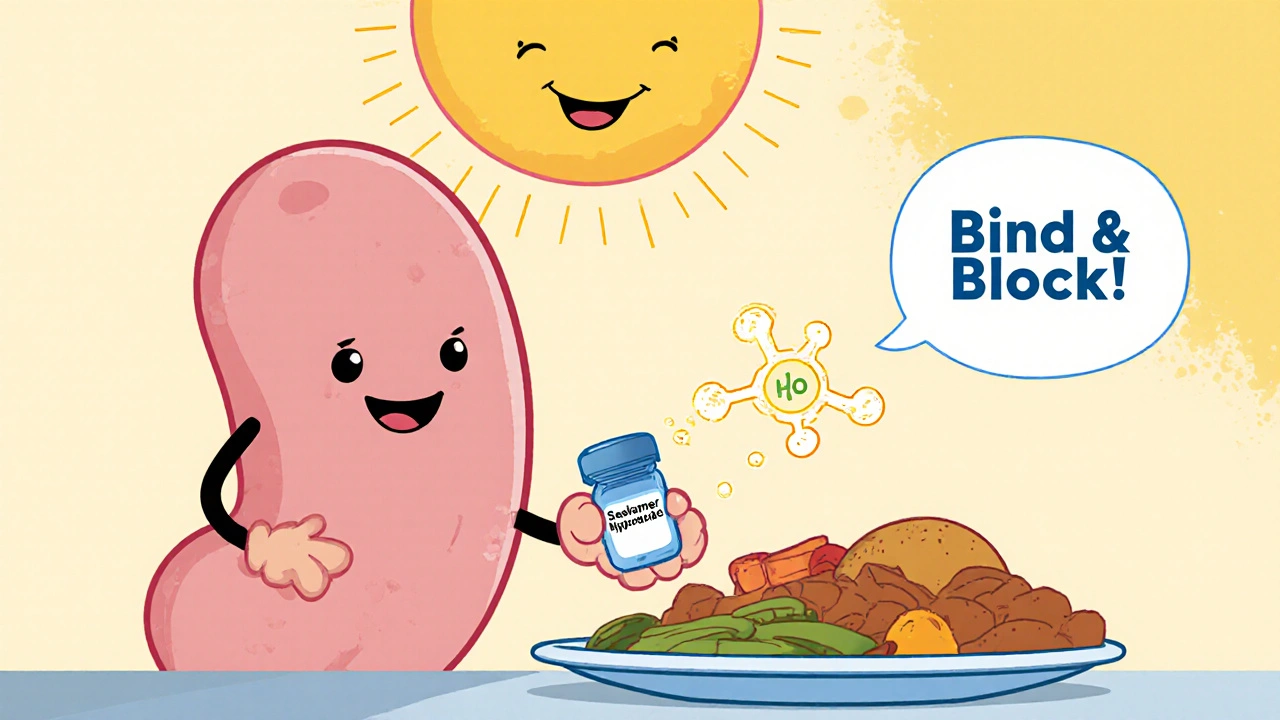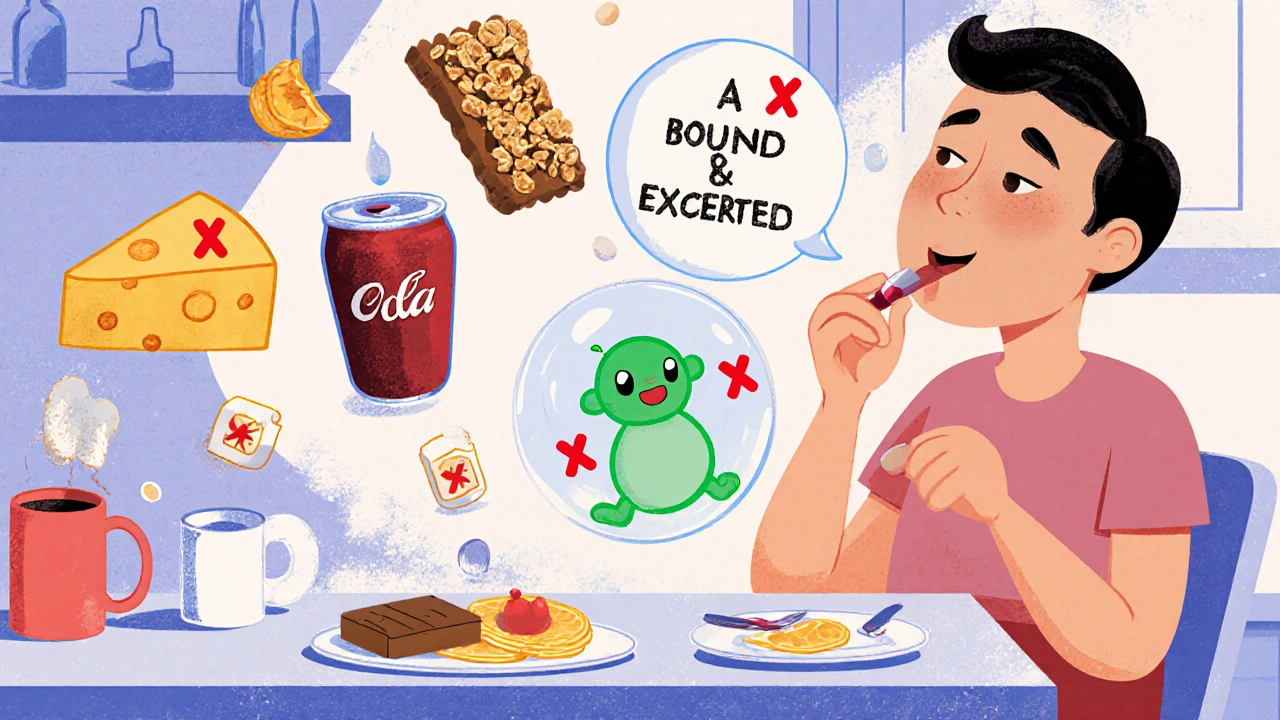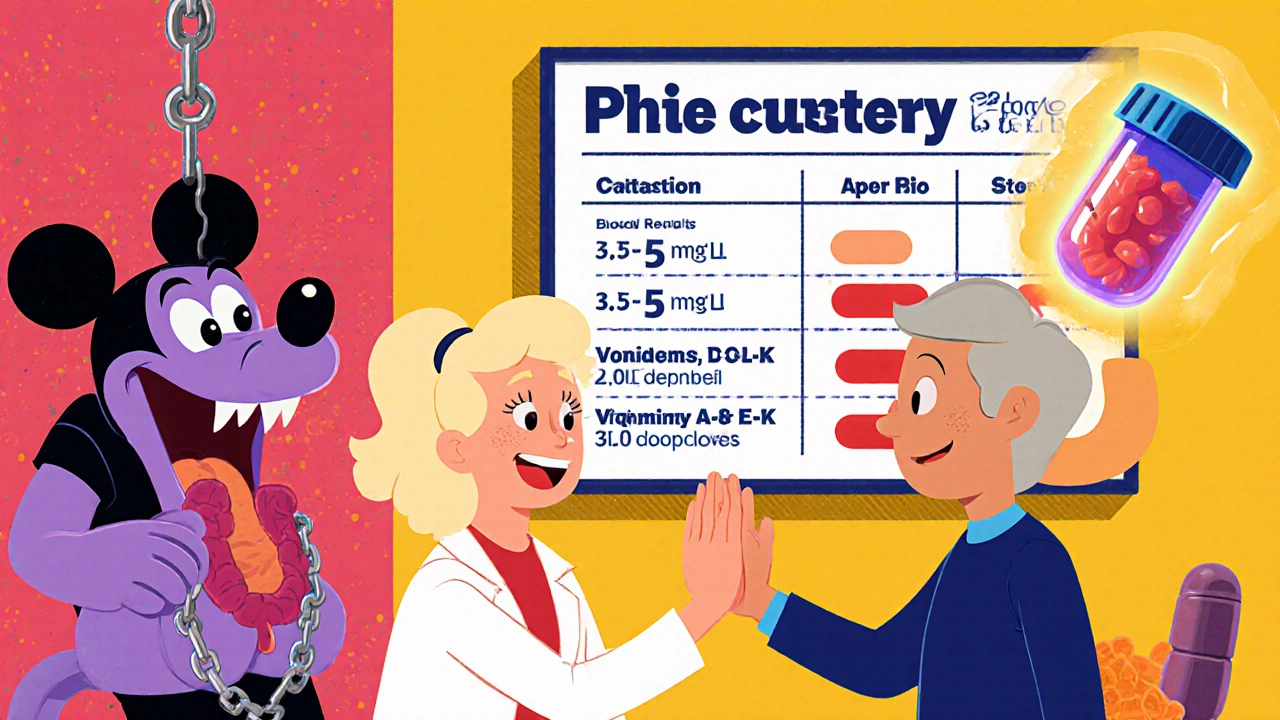Sevelamer Hydrochloride: Dosage and Administration Guidelines

Sevelamer hydrochloride is a phosphate binder used primarily in people with chronic kidney disease who are on dialysis. Its job is simple: it stops your body from absorbing too much phosphorus from the food you eat. High phosphorus levels can lead to serious problems like weak bones, heart damage, and itchy skin. But getting the dose right matters-too little won’t help, and too much can cause side effects like stomach upset or constipation.
How Sevelamer Hydrochloride Works
Unlike other phosphate binders that contain calcium or aluminum, sevelamer hydrochloride doesn’t absorb into your bloodstream. It works right in your gut. When you take it with meals, it binds to the phosphorus in food, forming a complex your body can’t absorb. That bound phosphorus then leaves your body through stool. This means it doesn’t raise your calcium levels or risk aluminum toxicity, which is why doctors often choose it for long-term use.
It’s not a cure. It’s a tool. You still need to follow a low-phosphorus diet. But when used correctly, sevelamer hydrochloride helps keep your blood phosphorus levels between 3.5 and 5.5 mg/dL-the target range recommended by the National Kidney Foundation.
Typical Starting Dosage
The usual starting dose for adults on dialysis is 800 mg to 1,600 mg taken with each meal. That means if you eat three meals a day, you’ll likely take three doses. The total daily dose usually ranges from 2,400 mg to 4,800 mg, but your doctor will adjust this based on your blood test results.
It’s important to take it with food. If you skip a meal, skip the dose. Taking it on an empty stomach won’t help and might cause nausea. The tablets are meant to be swallowed whole. Don’t crush, chew, or break them-they’re designed to release slowly in the digestive tract.
Adjusting Your Dose
Your doctor will check your serum phosphorus levels every 2 to 4 weeks after you start sevelamer. If your levels are still above 5.5 mg/dL, they’ll increase your dose in 800 mg increments per meal. Most people stabilize between 3,200 mg and 7,200 mg per day, divided evenly across meals.
Some patients need higher doses-up to 9,600 mg daily-especially if they eat a lot of processed foods or dairy, which are high in phosphorus. But going above that isn’t recommended without close monitoring. Higher doses increase the risk of bowel issues like constipation or bloating.
How to Take It Correctly
- Take sevelamer hydrochloride with every meal and snack that contains phosphorus.
- Swallow tablets whole with water. Do not crush or chew.
- If you miss a dose, take it as soon as you remember-but only if you’re still eating. If the meal is over, skip it.
- Don’t take it with other medications at the same time. Wait at least 1 hour before or after taking antibiotics, thyroid meds, or immunosuppressants.
- Keep a food diary. Note what you ate and when you took your dose. This helps your doctor see patterns.
Many people forget to take their doses with snacks. That’s a mistake. A granola bar, cheese stick, or soda can contain hidden phosphorus. If you snack, take a dose. Your pharmacist can help you plan dosing around your eating schedule.

Common Side Effects and How to Manage Them
The most common side effects are digestive: nausea, vomiting, diarrhea, constipation, and stomach pain. About 20% of users report these, especially when starting or increasing the dose.
Constipation is the biggest issue. If you’re struggling, your doctor might suggest:
- Increasing water intake to at least 2 liters per day
- Adding more fiber from vegetables, oats, or psyllium husk
- Using a stool softener like docusate sodium if needed
Some people get low levels of fat-soluble vitamins (A, D, E, K) because sevelamer can bind to them too. Your doctor should check your vitamin levels yearly. If they’re low, you may need a special supplement taken at least 4 hours apart from sevelamer.
Who Should Not Take It
Sevelamer hydrochloride isn’t for everyone. Avoid it if you have:
- A bowel obstruction or severe constipation
- A known allergy to sevelamer or any of its ingredients
- Low phosphorus levels (hypophosphatemia)
It’s also not approved for children under 6 or for people not on dialysis unless under strict supervision. Pregnant women should only take it if the benefit clearly outweighs the risk-there’s limited data on its use during pregnancy.
What to Avoid While Taking It
Some foods and meds interfere with sevelamer’s effectiveness:
- Calcium-based binders (like calcium acetate) - using both together can raise calcium too high
- Thyroid medications (levothyroxine) - take them at least 4 hours before sevelamer
- Antibiotics like ciprofloxacin or doxycycline - sevelamer can reduce their absorption
- Immunosuppressants like mycophenolate - timing matters
Also avoid phosphate additives in processed foods. Look for ingredients like “phosphoric acid,” “calcium phosphate,” or “sodium phosphate” on labels. These are hard to bind and can sabotage your treatment.

Monitoring Your Progress
Regular blood tests are non-negotiable. You’ll need:
- Phosphorus levels every 2-4 weeks at first, then every 3 months once stable
- CALCIUM levels to avoid hypercalcemia
- Parathyroid hormone (PTH) to check bone health
- Vitamin D and fat-soluble vitamins annually
If your phosphorus stays high despite taking the full dose, your doctor might switch you to sevelamer carbonate (a different salt form) or add another binder. Some patients do better with a combination approach.
What Happens If You Stop Taking It?
Stopping sevelamer hydrochloride without medical advice can be dangerous. Phosphorus levels can spike within days. That can lead to:
- Itchy, dry skin
- Bone pain and fractures
- Calcium deposits in blood vessels, heart, and lungs
- Increased risk of heart attack or stroke
Even if you feel fine, high phosphorus doesn’t always cause symptoms until damage is done. That’s why sticking to your schedule matters more than you think.
When to Call Your Doctor
Call your healthcare provider right away if you experience:
- Severe constipation or no bowel movement for 3+ days
- Signs of an allergic reaction: swelling, rash, trouble breathing
- Severe stomach pain or vomiting
- Unexplained weakness or irregular heartbeat
Don’t wait. These could be signs of complications that need quick action.
Final Tips for Success
Managing sevelamer hydrochloride isn’t just about pills. It’s about habits.
- Set phone reminders for each meal and snack.
- Keep a pill organizer labeled with meals.
- Work with a renal dietitian to plan low-phosphorus meals.
- Don’t be afraid to ask for help. Many dialysis centers offer free counseling.
- Track your progress. Note how you feel, your bowel habits, and your lab results.
Sevelamer hydrochloride works best when you treat it like part of your daily routine-not an afterthought. The goal isn’t perfection. It’s consistency. Even 80% adherence can make a big difference in your long-term health.

This is the most overhyped junk medicine I've seen in years. My cousin took this for six months and ended up in the ER with a bowel obstruction. They just push these pills because they're profitable, not because they work.
i just take mine with breakfast and dinner and forget about it honestly the hardest part is remembering not to eat cheese on everything but hey at least i dont have to deal with that itchy skin anymore
so you're telling me i need to swallow 1600mg of chalk with every snack or else my bones turn to dust? cool cool cool guess i'll just start carrying a pill case in my pocket like a good little dialysis zombie
you dont have to be perfect with this stuff but you do have to show up. even if you miss a dose here and there if you keep showing up your body knows you care. its not about being flawless its about being consistent. you got this
The administration of sevelamer hydrochloride necessitates strict temporal separation from concomitant pharmaceutical agents due to its anionic polymeric structure which impairs gastrointestinal absorption of co-administered compounds. Failure to adhere to this protocol constitutes a clinically significant pharmacokinetic interference.
i know it feels like a full time job but trust me the first time your phosphorus levels drop and you stop feeling like your bones are crumbling youll realize this is worth it. dont give up. talk to your dietitian. theyve seen it all and theyre on your side
took mine with lunch today and forgot about the snack later. ended up with a headache and weird muscle cramps. guess i need to be better. anyone else get brain fog from this stuff?
theyre putting phosphorus binders in the water supply. its all part of the dialysis-industrial complex. you think this is medicine? its control. they want you dependent. look at the ingredients. nothing natural. nothing real.
if you cant follow basic instructions like taking your meds with food you dont deserve to be on dialysis. this isn't hard. its not complicated. its just discipline. stop making excuses and take your pills.